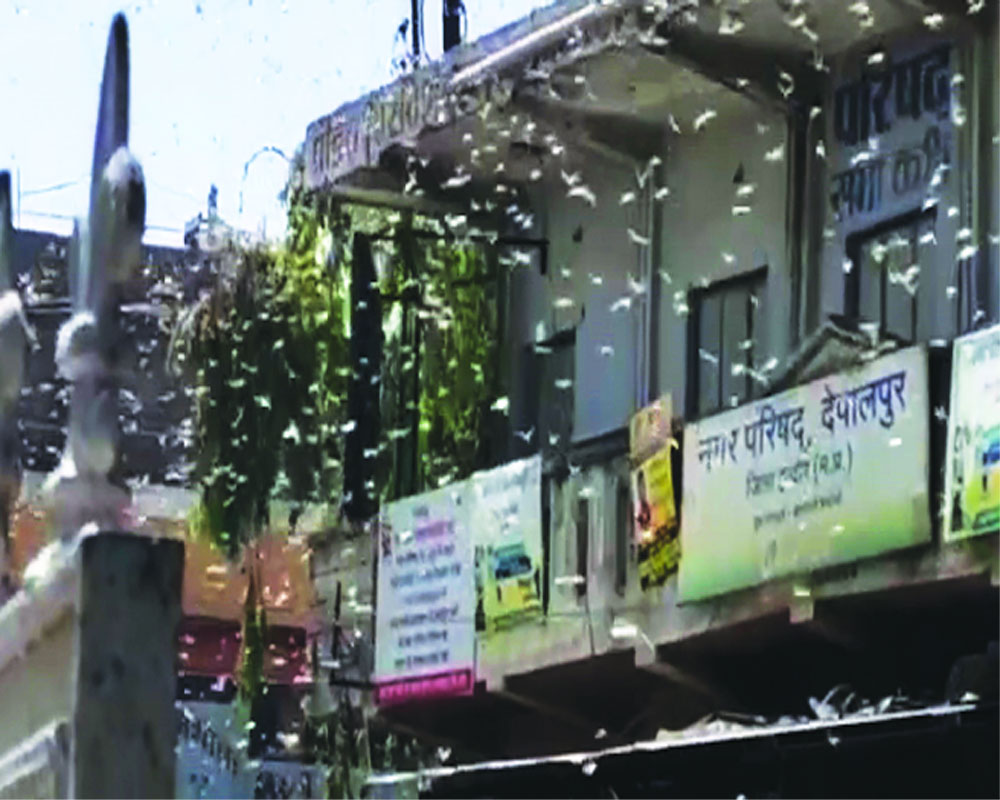Crops on 15 lakh acres affected across six States since Dec last
Nearly 45-50 districts in six States — Maharashtra, Uttar Pradesh, Punjab, Madhya Pradesh after Rajasthan and Gujarat — are under attack of crores of desert locusts that entered from Pakistan last year.
It is estimated that crops on 10-15 lakh acres have been affected across six States since December last year while the Government estimates around one lakh acres of cotton, summer pulses and vegetables crops have been affected so far. The Ministry of Agriculture estimates that not much damage to crops is reported as sowing has not taken place in most of the areas and harvest of winter crops is over.
The Shivraj Singh Chouhan Government in Madhya Pradesh is planning to declare the locust swarm attacks as natural disaster, following a survey on the losses. Haryana on Thursday issued high alert in 10 districts for farmers while Odisha and Chhattisgarh also issued advisories to farmers.
Delhi’s neighbouring region Noida, Ghaziabad, Gurugram have also issued advisories to this effect.
Interestingly, India has taken up the locust issue with Pakistan ,but there has been no response from Pakistan yet.
According to Locusts Warning Organisation of the Ministry of Agriculture, the bigger problem will come once the present swarms breed. An adult female locust lays 80-90 eggs thrice in her three-month life cycle. If left uncontrolled, a swarm can grow exponentially to 40-80 million locusts per square kilometer.
Farmers are worried as the pest could damage their summer kharif crops during the peak season of July-August-September. Farmers have been advised to play loud music to drive the insects away and save crops. Locusts don’t attack animals or humans but can devastate crops and other areas of greenery.
LWO’s Deputy Director KL Gurjar said there being no crops in the fields, the locusts have moved across States attracted by green cover. “The bigger problem will come once the present swarms breed. An adult female locust lays 80-90 eggs thrice in her three-month life cycle. If left uncontrolled, a swarm can grow exponentially to 40-80 million locusts per square kilometer,” officials said. The locusts will start laying eggs after the monsoon starts and continue breeding for two more months, with newer generations rising during the growth phase of the kharif crop.
The first swarms were sighted along the India-Pakistan border in December last year months ahead of the usual time of arrival.
The Ministry of Agriculture on Wednesday informed that locust control operations have been stepped up in affected States to combat the menace. So far, 89 fire brigades for pesticide spray; 120 survey vehicles; 47 control vehicles with spray equipments and 810 tractor mounted sprayers have been deployed for effective locust control. It will also deploy drones in the work.
The Centre will import 60 sprayers from the United Kingdom. Of them, 15 sprayers are expected to arrive by June 11, 20 more by June 25, and remaining 25 by July 9 to ramp up its ongoing operations to control locust. These sprayers will be deployed in Rajasthan, Gujarat, Punjab, Madhya Pradesh and Uttar Pradesh, depending on extent of swarms’ presence.
About 90,000 hectares in 20 districts of Rajasthan have been affected due to the locust attack. Crop over 4,000 hectares in Sri Ganganagar and 100 hectares in Nagaur have been destroyed. Swarms of locust have moved from Sri Ganganagar, Nagaur, Jaipur, Dausa, Karauli and Swai Madhopur towards other areas in Uttar Pradesh and Madhya Pradesh after the authorities conducted operations to tackle them.
According to Dr Om Prakash Choudhary, Commissioner, Agricultural Department of Rajasthan, drones were used to kill locusts in Jaipur. , “We will use drones to monitor locusts in the terrains which are difficult for us to access,” he said.
Haryana has issued a high alert in seven districts -- Sirsa, Fatehabad, Hisar, Bhiwani, Charkhi Dadri, Mahendragarh and Rewari after locust swarms attacked crops in neighbouring Rajasthan and a few other States.
In MP, farmers in Jabalpur have arranged water tankers and chemicals for spraying in order to drive away locusts from attacking farms. Besides, farmers in Sehore district have been beating utensils. Locusts were also spotted over Panna Tiger Reserve where they feasted upon wild plants and trees. This saved loss of agricultural crops here.
After damaging crops in Rajasthan and Madhya Pradesh, swarms of locusts entered Uttar Pradesh’s Jhansi district in what is being described as the worst attack in 26 years.
In Maharashtra, swarms of locusts damaged orange crops and horticulture crops in Nagpur and Wardha districts. They crossed into Balaghat district of Madhya Pradesh from eastern Maharashtra on Thursday afternoon.


























